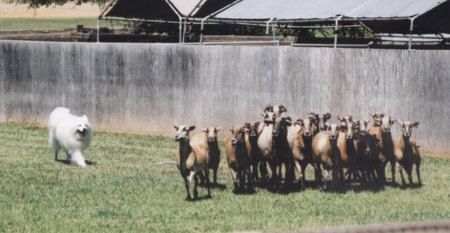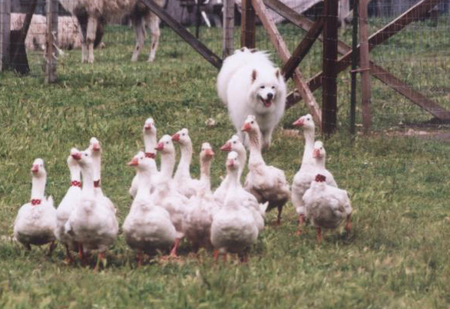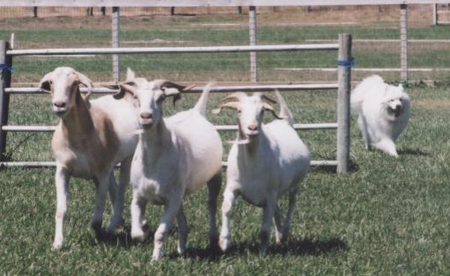Herding dogs have long been important in livestock industries. They are used in many countries of the world in day to day activities on sheep, goat, and cattle ranches. Today there is an increased interest by ‘weekend herders” (who live in cities and don’t own livestock) interested in working with their dogs and helping preserve the talents and abilities of the herding dog. Although not technically a “herding breed” the Samoyed does have herding in their roots. With the Samoyede people they were used to move large herds of reindeer from place to place. Samoyeds belong to the ‘loose-eyed’ group of herders, including collies, Australian Shepherds, Shetland Sheepdogs, Belgian Sheepdogs and Tervurens, etc. This group uses their body language and upright body position to control and move the stock, rather than the ‘eye’ used by Border collies.
 Few activities offer the variety of situations and the opportunity of real team work between handler and dog. Herding dogs must cooperate with the handler, yet use their own initiative and judgment. They must be able to work with gentleness, yet show strength in facing up to a stubborn animal.
Few activities offer the variety of situations and the opportunity of real team work between handler and dog. Herding dogs must cooperate with the handler, yet use their own initiative and judgment. They must be able to work with gentleness, yet show strength in facing up to a stubborn animal.
Competitive herding tests and trials are offered through the American Kennel Club (AKC), American Herding Breed Association(AHBA), and Australian Shepherd Club of America (ASCA). Samoyeds are capable of herding in any of these venues on sheep, ducks, and/or cattle.
Before starting in herding you should ensure you will have the time and means to continue, since it’s not fair to your dog to just let them see stock every so often.
Also you need to ensure that your dog is physically and mentally sound and in good condition. Since there is running, quick turns, stops, etc. involved, an unfit dog can be injured. As with any working activities, puppies can be introduced to herding on a very limited basis at an early age in a safe environment. Actual training should wait until the dog is a least six to nine months of age. Herding is a lot of physical and mental activity and can be stressful to the dog. In addition, the handler should be in good condition. He/she will have to be able to run, move quickly, stand up to sheep, etc.

A good all-breed trainer (one that works with many breeds of dogs, particularly loose-eyed breeds) should be located and training should be done on a routine basis – ideally at least once a week. A good trainer will have good stock that is suitable for a beginning dog. It is NEVER a good idea just to try your dog on your neighbor’s stock. Before starting training, your dog should have a reliable come and also a stop of some kind (sit, down, stand). These can be taught and practiced away from stock and should be done in many different locations and situations. During beginning training the handler stays close to the stock, teaching the dog to circle or balance behind the stock. A crook, pole, etc. can be used to help direct the dog until he/she learns and understands flanking commands. As the dog becomes more experienced, he/she can work further and further away from the handler taking commands by voice or whistle.
Most Samoyeds have the instinct to herd, as shown by the high percentage of passes at instinct tests. However, because of their independent nature, one must work with that natural instinct and channel it into working as a dog/handler team, rather than letting the dog work totally independently. Samoyeds tend to prefer actual work (ranch work, chores, etc.) to just doing trial courses. They are particularly suited for ‘ranch course’ and large flock courses, since each course differs and thereby giving the Samoyed the variety they enjoy.
 Websites devoted to herding, such as www.stockdog.com and www.herdingontheweb.com contain a wealth of information for beginners, as well as lists of instructors in most states.
Websites devoted to herding, such as www.stockdog.com and www.herdingontheweb.com contain a wealth of information for beginners, as well as lists of instructors in most states.
The dog in these three pictures is: HTCH U-CD White Wolf Wild & Free, CD, RE, HI, OTDsd, NAJ, NJP, WSXM, TDI. Owned by Ann and Jan Schlobohm